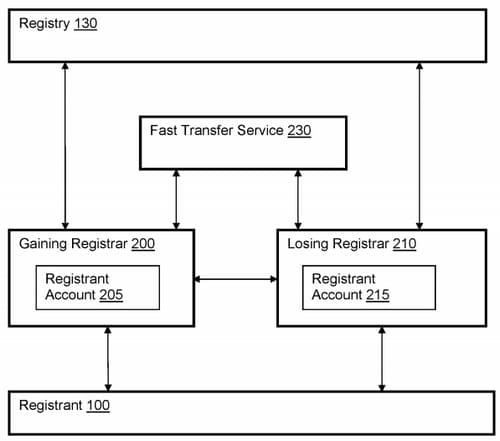Process would eliminate pesky AuthCodes in favor of registrant data verification.

The U.S. Patent and Trademark Office granted patent number 10,581,799 (pdf) to GoDaddy (NYSE: GDDY) today for “Method for a losing registrar to transfer a domain name from the losing registrar to a gaining registrar.”
The patent describes a way for people to transfer domain names to a new (winning) registrar without logging in to the old (losing) registrar’s account. In effect, it eliminates those pesky authorization codes.
Currently, before transferring a domain name, a customer needs to log into their account at the losing registrar to request an authorization code. They then must provide this authorization code to the winning registrar.
Under the proposed system, the winning registrar would verify the owner’s information instead of getting the authorization code. To do this, the winning registrar would validate the information in Whois, perhaps by sending a verification to the email address and an SMS verification to the phone number in Whois. The patent application was filed just after GDPR went into effect and contemplated access to Whois. An alternative to Whois is for the winning registrar to ping the losing registrar, which would provide the contact information that needs to be validated.
This might sound familiar. In the old days, transfers were predicated on sending an email to the contact in Whois. It’s a similar concept.
The process would not override transfer locks, so registrants would need to log in at the losing domain name registrar to remove these if they are in place.






Call me old school, but the more manual domain name transfer verifications, the better.
Too much domain automation in the domain Industry is going to get domains lost or stolen IMO.
Fast transfer overrides transfer locks at Afternic and GoDaddy Auctions. Your domain gets transferred to the buyer when sold, even if the domain is locked.
So it would not surprise me if transfer locks get overridden with Godaddy’s new
AuthCode-less system.
Right, they patent it so nobody else can use – and then, there is no way to use it, because it’s inter-registrar. Right.
You don’t just patent things so that no one else can use them.
An IPR disclosure of that kind usually kills any attempt of protocol development in IETF. People hate paying royalties.
As I’ve pointed out for years, ICANN working groups determine the rules on how a number of technical operations are required to be carried out, but requires no disclosure of IP interests among the participants in that process. It’s a classic game, and yet another failure of ICANN to act as every other responsible standards-relevant organization manages to do.
A patent right give you the right to exclude others from making, using, importing, selling or offering to sell the claimed invention. It does not give you the right to use the claimed invention.
I wonder what will Network Solutions do…
they take minimum 3 days to send Auth code after registrants request.
I doubt their working hours mainly concentrate on these during all three days…and then simply send an email with Auth code…
This patent can ruin their work culture, very precious way to eat up registrants time and mind!!
This would require either an ICANN policy change or agreement by both registrars.